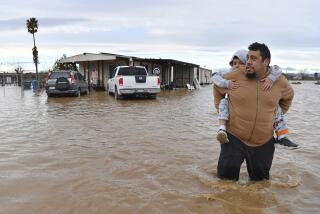Tropical StormsHurricane Lili caused some of the...
- Share via
Tropical Storms
Hurricane Lili caused some of the worst damage in decades as it raked across the heart of Cuba. As many as 5,600 houses were destroyed and vast tracts of sugar, banana and coffee crops were wiped out by the storm. Lili went on to batter the Bahamas before losing force over the central North Atlantic.
At least four people were killed as typhoon Beth swept through Luzon Island in the northern Philippines. The storm later passed across the South China Sea and brought more rain to already flood-stricken Vietnam.
Typhoon Carlo produced high winds and heavy rains over the northern Marianas Islands, then dissipated to the east of Japan. Tropical cyclone Antoinette formed briefly in the eastern Indian Ocean, and weak cyclones 05A and 05B passed harmlessly over the Arabian Sea.
Floods
An Atlantic coastal storm brought rains said to be of bibilical proportions during a two-day deluge over New England. Massachusetts and Maine were especially hard- hit by inundations and high winds that caused widespread power failures.
Troops in India conducted a massive rescue operation in the country’s south as the death toll from heavy flooding surpassed 300. Rescuers recovered 138 bodies across the coastal state of Andhra Pradesh, while 148 others were missing and presumed drowned.
Earthquakes
The historic Croatian town of Ston suffered further damage from ongoing swarms of earthquakes that have rocked the region for a month. No injuries were reported from the latest shaking, and damage was minor.
One of the year’s strongest temblors rocked Japan’s southern island of Kyushu, producing a tsunami that swamped some coastal areas with three feet of water. Only minor structural damage was reported from the quake.
Earth movements were also felt in southwestern Australia, southern Mexico, southern Alaska and in southeastern Wyoming.
Oldest Life
Scientists in Australia saa say they have found a 40,000- year- old shrub that may be the world’s oldest living organism. The shrub has grown to cover two secluded river gullies in Tasmania’s remote southwestern wilderness. Dubbed “king’s holly,” the plant is believed to have begun life well before the last ice age, according to Stephen Harris of the Tasmania Parks and Wildlife Service. The shrub is a sterile species that clones itself, and does not need other plants to reproduce.
Endangered Bees
European beekeepers are concerned over the spread of varroa, an Asian parasite, that threatens to decimate their hives. Most keepers are reluctant to combat the plague with chemicals that might wind up in the honey supply. Peter Rosenkranz, head of the Apirian Research Center in Germany’s Baden- Wurttemberg state, says that the bees have no immune mechanism against varroa, raising fears that there may soon be areas of Europe where bees have completely died out.
Additional Sources: U.S. Climate Analysis Center, U.S. Earthquake Information Center and the World Meteorological Organization.
More to Read
Sign up for Essential California
The most important California stories and recommendations in your inbox every morning.
You may occasionally receive promotional content from the Los Angeles Times.













